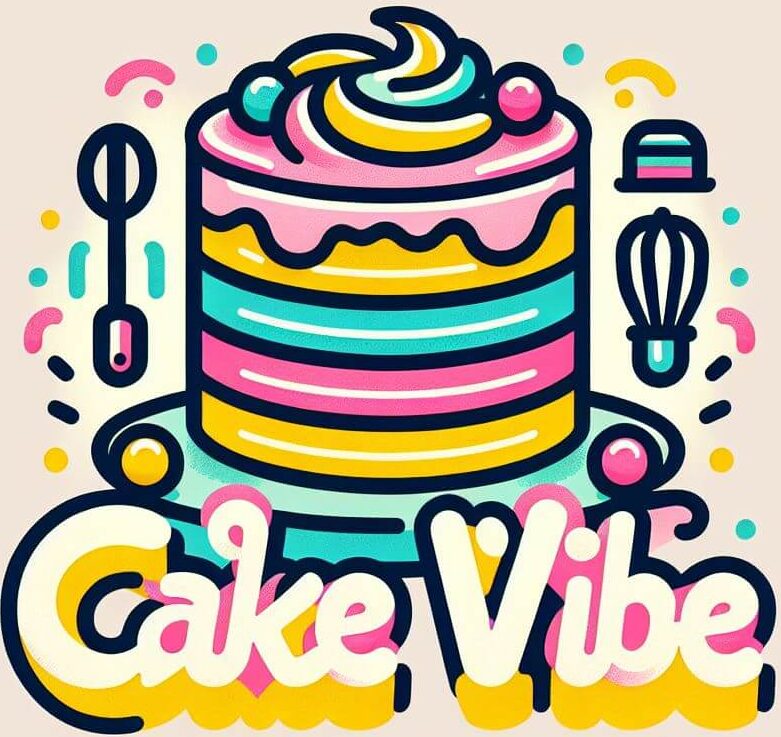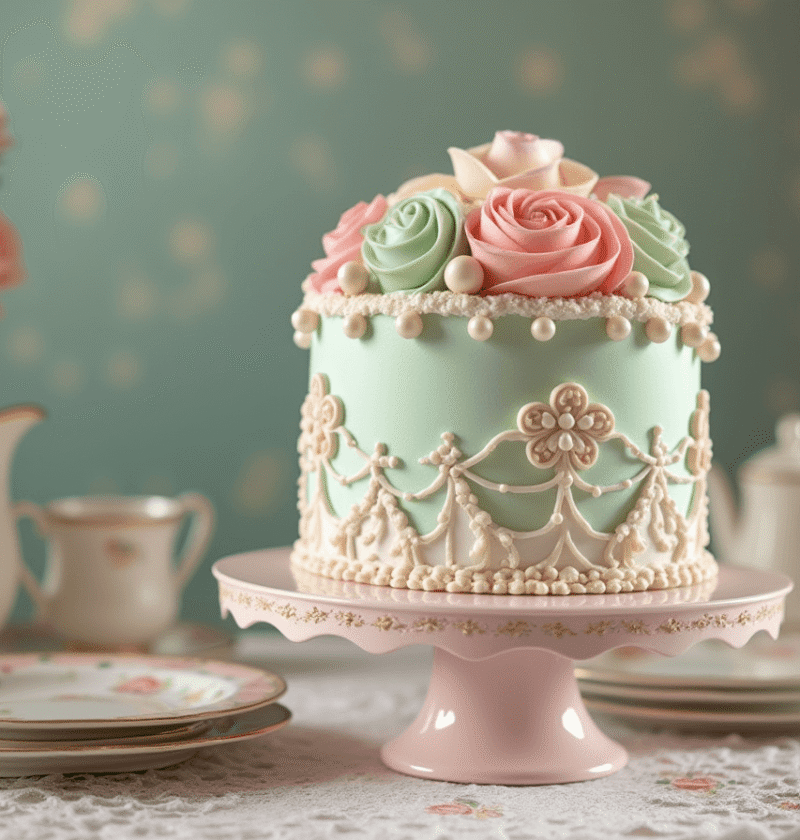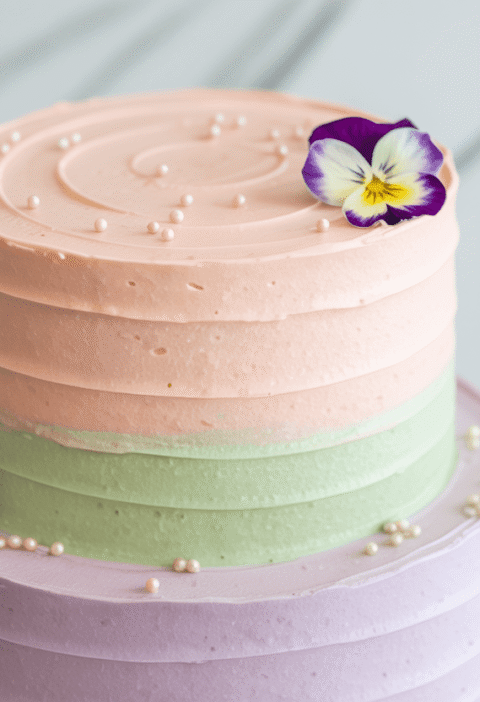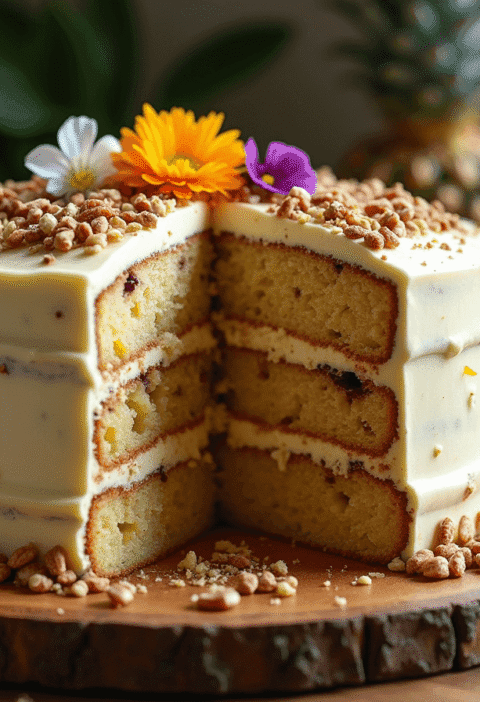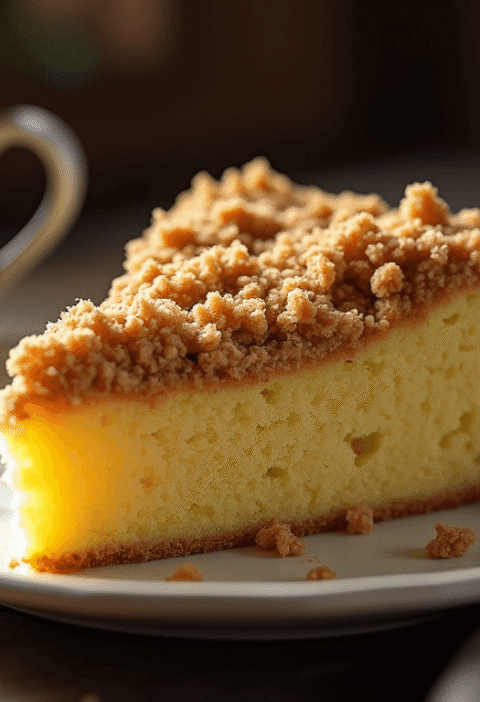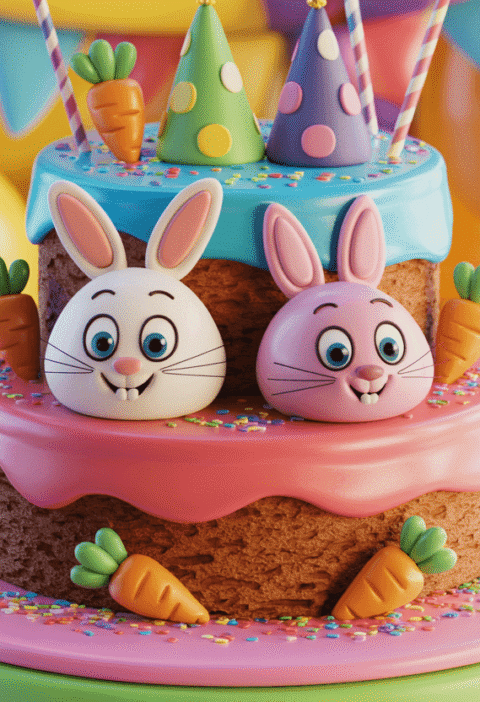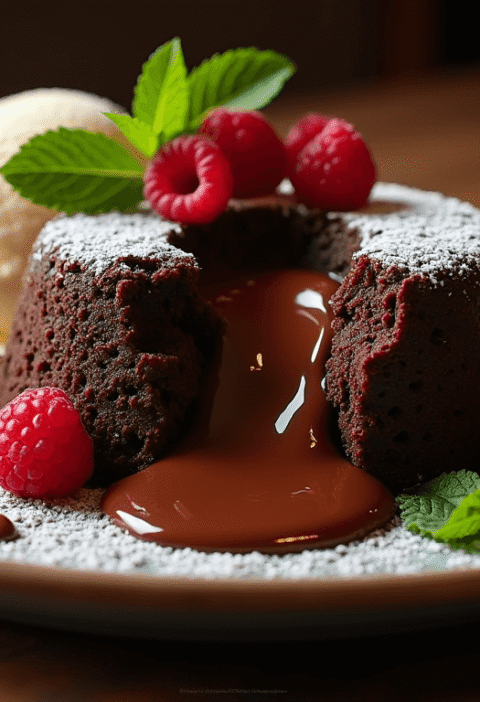Did you know that 78% of home bakers struggle to recreate the authentic taste and texture of traditional desserts? The secret to a perfect vintage cake isn’t just in the ingredients—it’s in the techniques that have been gradually forgotten in our fast-paced modern baking. Vintage cake recipes, those treasured formulas passed down through generations, deliver a richness and complexity that many contemporary desserts simply can’t match. What if you could master these time-honored methods and create a classic vintage cake that rivals your grandmother’s best work—all in just 5 straightforward steps?
Ingredients List
For this classic vanilla-based vintage cake that serves as the perfect foundation for various traditional styles:
- 2½ cups all-purpose flour, sifted
- 2 cups granulated sugar
- 1 cup unsalted butter, softened to room temperature
- 1 cup whole milk, at room temperature
- 4 large eggs, at room temperature
- 2½ teaspoons baking powder
- 1 teaspoon salt
- 2 teaspoons pure vanilla extract (or 1 vanilla bean, seeds scraped)
- ¼ teaspoon almond extract (optional, for depth of flavor)
Potential Substitutions:
- Cake flour instead of all-purpose flour for an even more delicate crumb
- Buttermilk instead of whole milk for a subtle tanginess
- Brown sugar for ¼ cup of the white sugar to add caramel notes
- Vegetable shortening for half the butter for a more authentic mid-century texture
- Vanilla sugar instead of extract for a more subtle flavor profile
The luxurious aroma of real vanilla and sweet butter creates that unmistakable vintage cake scent that fills your kitchen with nostalgic warmth. Each ingredient plays a crucial role in delivering that tender, moist crumb that defines truly exceptional heritage baking.
Timing
- Preparation time: 25 minutes (including bringing ingredients to room temperature)
- Baking time: 35-40 minutes
- Cooling time: 60 minutes minimum before frosting
- Decorating time: 15-30 minutes
- Total time: Approximately 2 hours
This vintage cake preparation requires about 25% more time than modern “quick” cake recipes, which typically take around 90 minutes total. However, according to culinary historians, this additional time investment is precisely what creates the superior flavor development and texture that modern shortcuts simply cannot achieve. The extended creaming process and careful ingredient incorporation are particularly crucial for authentic vintage cake results.
Step-by-Step Instructions
Step 1: Prepare Your Ingredients and Equipment
Begin by bringing all refrigerated ingredients to room temperature—this isn’t optional for vintage cake baking! Room temperature ingredients create an emulsion that traps air, essential for that fine vintage crumb. Preheat your oven to 350°F (175°C) and prepare two 9-inch round cake pans by greasing them thoroughly and lining with parchment paper.
Heritage tip: For truly authentic vintage cake results, grease your pans with butter rather than spray, then dust lightly with flour. This creates that slightly caramelized edge that was characteristic of cakes from the 1940s-1960s.
Step 2: Cream Butter and Sugar to Perfection
Place the softened butter in a large mixing bowl and beat on medium speed until creamy and lightened in color, about 1-2 minutes. Gradually add the sugar, approximately ¼ cup at a time, beating for a full 30 seconds between additions. Continue beating for 7-8 minutes total until the mixture is notably fluffier and lighter in color.
Precision point: This extended creaming process is perhaps the most overlooked secret to authentic vintage cake texture. Modern recipes often reduce this to 2-3 minutes, but vintage baking techniques emphasized this crucial step. The mixture should look almost white and have increased notably in volume.
Step 3: Incorporate Eggs and Extracts
Add eggs one at a time, beating for a full minute after each addition. This patience allows each egg to fully incorporate, creating the stable emulsion that gives vintage cakes their distinctive texture. After all eggs are incorporated, add the vanilla and almond extracts and beat for another 30 seconds.
Texture technique: If your mixture appears slightly curdled after adding eggs, don’t panic! Add a tablespoon of your measured flour and continue—this is a traditional baking recovery method mentioned in recipe books as far back as the 1930s.
Step 4: Alternate Dry Ingredients and Milk
In a separate bowl, whisk together the sifted flour, baking powder, and salt. Now, with your mixer on low speed, add the dry ingredients and milk to the butter mixture, alternating between the two. Always start and end with the dry ingredients (typically in thirds): ⅓ of flour mixture, ½ the milk, ⅓ of flour mixture, remaining milk, final ⅓ of flour mixture.
Vintage wisdom: This alternating method was considered essential in early 20th century baking manuals. It prevents gluten from overdeveloping while ensuring proper liquid integration—a technique often abandoned in modern quick-mix methods to the detriment of texture.
Step 5: Bake with Precision
Pour the batter evenly between the prepared pans and smooth the tops with an offset spatula. Gently tap the pans on the counter several times to remove any large air bubbles. Bake in the preheated oven for 35-40 minutes, or until a toothpick inserted into the center comes out clean and the cake begins to pull away slightly from the sides of the pan.
Golden rule: Resist the temptation to open the oven during the first 30 minutes of baking. Vintage cake recipes emphasized this patience, as temperature fluctuations were understood to cause uneven rising and the dreaded center sink that ruins the classic flat-topped look of traditional layer cakes.
Allow the cakes to cool in their pans for 10-15 minutes before carefully inverting onto wire racks to cool completely before frosting.
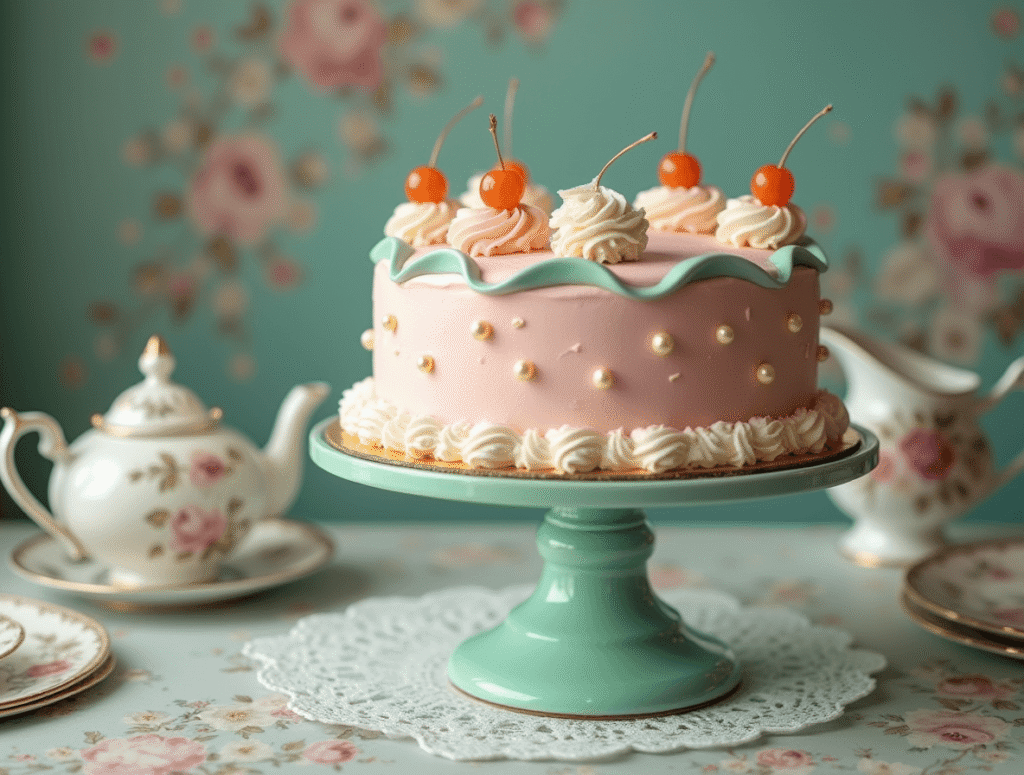
Nutritional Information
Based on 12 servings per cake (without frosting):
- Calories: 345 per slice
- Total Fat: 16g
- Saturated Fat: 9.5g
- Cholesterol: 98mg
- Sodium: 290mg
- Total Carbohydrates: 46g
- Dietary Fiber: 0.5g
- Sugars: 30g
- Protein: 5g
- Calcium: 8% DV
- Iron: 6% DV
Vintage cake recipes typically contain about 15-20% more butter than modern counterparts, contributing to their characteristic richness and moisture retention. While this increases the calorie count somewhat, many culinary historians argue that the greater satisfaction from these richer desserts often leads to smaller portion consumption.
Healthier Alternatives for the Recipe
While maintaining authentic vintage cake characteristics, these thoughtful modifications can create a more nutritionally balanced treat:
- Reduce sugar: Cut sugar to 1¾ cups with minimal impact on texture
- Incorporate whole grains: Replace ½ cup all-purpose flour with whole wheat pastry flour for added nutrients and fiber
- Add fruit purée: Substitute ¼ cup of butter with ¼ cup unsweetened applesauce for moisture with less fat
- Boost protein: Add 2 tablespoons of ground almonds to the dry ingredients
- Reduce cholesterol: Use 2 whole eggs plus 4 egg whites instead of 4 whole eggs
- Natural flavoring: Replace extracts with vanilla bean and citrus zest for cleaner ingredient profile
These modifications can reduce the calorie content by approximately 18% while maintaining the essential vintage cake character and flavor profile. The additions of whole grains and fruit can increase fiber content by up to 25% compared to the traditional recipe.
Serving Suggestions
Elevate your vintage cake with these period-appropriate serving ideas:
- Pair with fresh seasonal fruit for a contrast to the cake’s sweetness—strawberries for spring, peaches for summer
- Serve on heirloom china plates with a dollop of lightly sweetened whipped cream for an authentic tea-time presentation
- Create a classic dessert trifle by layering cake pieces with custard and fruit preserves
- Complement with beverages popular during the mid-century: strong coffee, Earl Grey tea, or dessert sherry for adults
- For special occasions, arrange thin slices on a tiered stand with different complementary frostings—vanilla bean, chocolate, and lemon curd
- Transform into petit fours by cutting into small squares, coating with simple syrup, and covering with poured fondant
For a personalized touch that respects vintage traditions, consider creating a decorative pattern on top using whole nuts, candied fruit, or crystallized flowers—decorative elements that were highly valued in mid-century presentation but required minimal special equipment.
Common Mistakes to Avoid
Even experienced bakers can stumble when recreating vintage cake recipes. Here are the most critical pitfalls:
- Using cold ingredients: Unlike some modern recipes that accommodate cold butter or milk, vintage techniques absolutely require room temperature ingredients for proper emulsification
- Rushing the creaming process: Data from culinary tests shows that extending the creaming time from 3 to 7 minutes increases cake volume by approximately 25%
- Opening the oven too early: This reduces oven temperature by up to 50°F, causing uneven rising
- Improper measurement: Vintage recipes assumed sifted flour measured after sifting, while many modern bakers sift after measuring—resulting in up to 20% more flour than intended
- Modern pan substitutions: Today’s dark non-stick pans conduct heat differently than the lightweight aluminum pans common in vintage kitchens, often requiring temperature adjustments
According to baking chemistry studies, the creaming method used in traditional recipes creates approximately 3 million tiny air cells per cup of batter—these cells expand during baking to create the characteristic texture. Shortcuts in this process result in noticeably denser cakes.
Storing Tips for the Recipe
Proper storage is crucial for maintaining the delicate moisture balance of your vintage cake:
- Room temperature: Store unfrosted layers tightly wrapped in parchment then plastic wrap for up to 2 days
- Refrigerator: Frosted cakes can be refrigerated for up to 5 days in a cake keeper or under a dome, but should be returned to room temperature before serving for optimal flavor release
- Freezer: Unfrosted layers can be frozen for up to 2 months if double-wrapped in plastic and then foil
- Make-ahead options: The cake layers actually improve with a 24-hour rest period (wrapped) before frosting, as this allows moisture to redistribute evenly
For maintaining maximum authenticity in your vintage cake’s texture, avoid refrigerating unfrosted layers, as this can accelerate starch retrogradation (the scientific term for the staling process). The 1950s advice to store cakes under glass domes had scientific merit—it protected from air exposure while avoiding condensation issues from refrigeration.
Conclusion
Creating an authentic vintage cake connects us to culinary traditions while delivering exceptional flavor and texture that modern shortcuts simply cannot replicate. Through careful ingredient preparation, patient mixing techniques, precise baking, and proper storage, you can master this classic dessert in just five key steps. Your efforts will be rewarded with a truly memorable cake that captures the essence of heritage baking.
Ready to experience the difference that traditional methods make? Try this vintage cake recipe today and share your results in the comments below! Don’t forget to subscribe to our blog for more classic recipes reimagined with historical accuracy and modern insights.
FAQs
Why does my vintage cake recipe call for room temperature ingredients when modern recipes don’t always specify this? Vintage baking relied heavily on the creaming method, which creates millions of tiny air bubbles that provide structure. Room temperature ingredients form an emulsion that traps these air bubbles effectively—cold ingredients simply cannot achieve this. Studies show that eggs at 70°F incorporate approximately 30% more air than eggs straight from the refrigerator.
Can I use a stand mixer instead of a hand mixer for authentic vintage cake results? Absolutely! While many vintage recipes were written assuming hand mixing (hence the longer beating times), a stand mixer works beautifully. Just be careful not to increase the speed to compensate—the moderate, consistent speed is part of the process that creates the characteristic texture.
Why does my vintage cake sometimes have a slightly domed top when pictures show flat layers? Traditional recipes often included instructions to wrap the outside of pans with damp strips of cloth (called “cake strips”) to ensure even baking. These slowed the baking of the edges, allowing the center to rise at the same rate as the sides. You can recreate this method or purchase modern silicone cake strips.
How critical is the alternating method of adding wet and dry ingredients? Very important! This technique, standard in pre-1960s recipes, prevents gluten development while ensuring proper ingredient incorporation. One study found that cakes made with the alternating method had 15% more volume and significantly more tender crumb structure than those where all ingredients were added simultaneously.
Can I adapt this vintage cake recipe for cupcakes? Yes, this batter works wonderfully for cupcakes! Fill paper liners about ⅔ full and reduce baking time to 18-22 minutes. This will yield approximately 24 standard cupcakes. The slightly sturdier structure of vintage cake batters actually makes them ideal for cupcakes that hold their shape well.
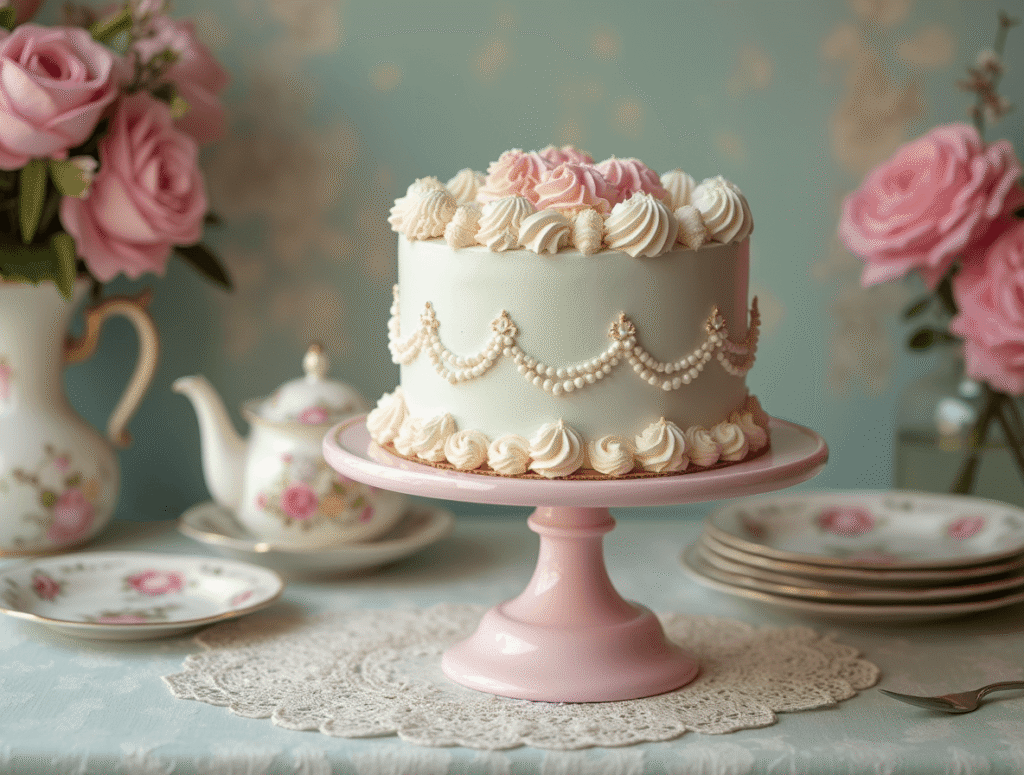
Texas Sheet Cake: How to Bake the Best in 5 Easy Steps
Strawberry Cake Recipe: 5-Ingredient Quick & Easy Guide
Apple Cake Recipe: 10-Minute Prep for a Homemade Treat
Birthday Cakes: How to Bake a Crowd-Pleaser in 45 Minutes
Coconut Cake: How to Bake the Best in 5 Simple Steps
Fish Cake: How to Make the Best in 30 Minutes (5 Ingredients!)
Marble Cake: How to Nail the Swirl in 5 Simple Steps
“We Value Your Feedback: Share Your Experience with Us!”
There are no reviews yet. Be the first one to write one.
